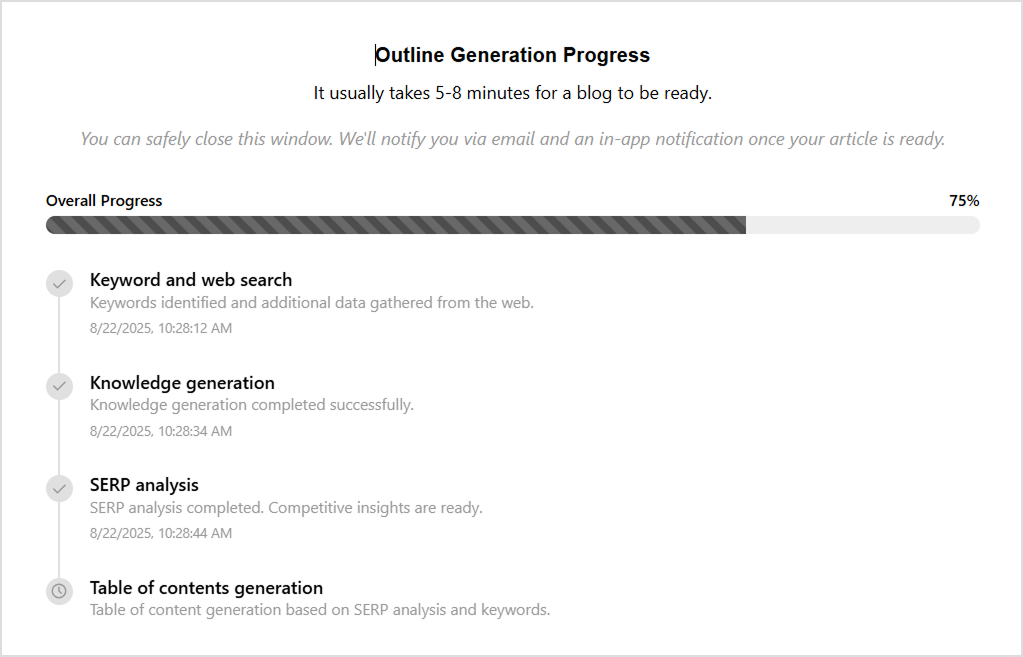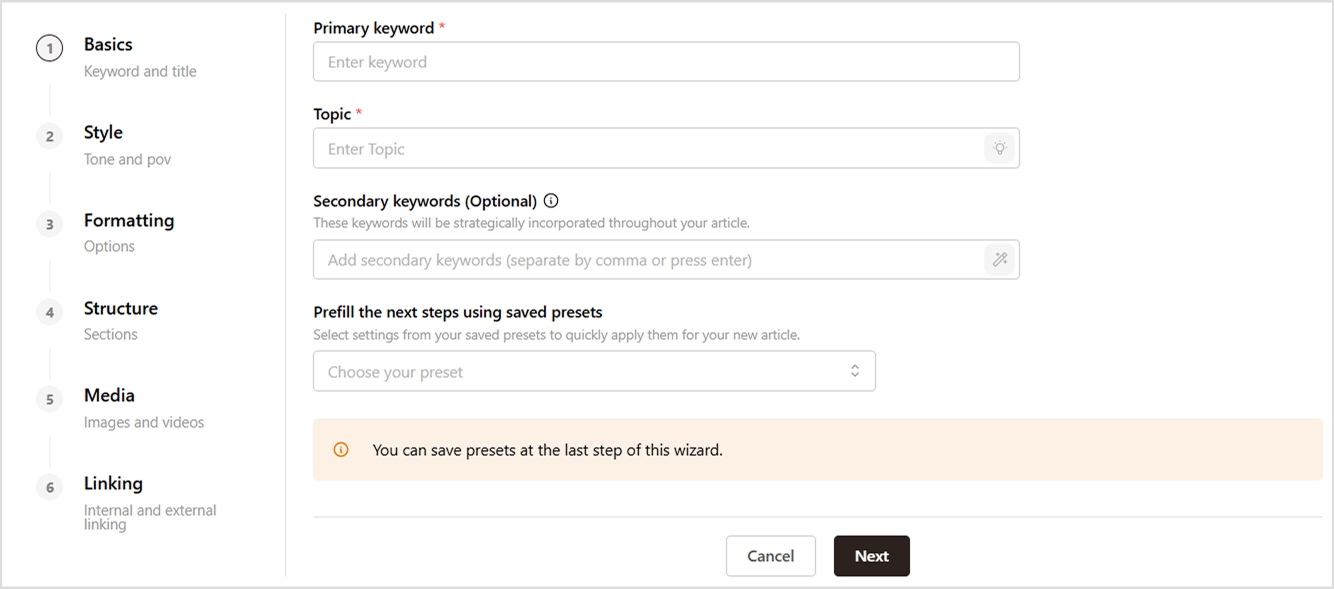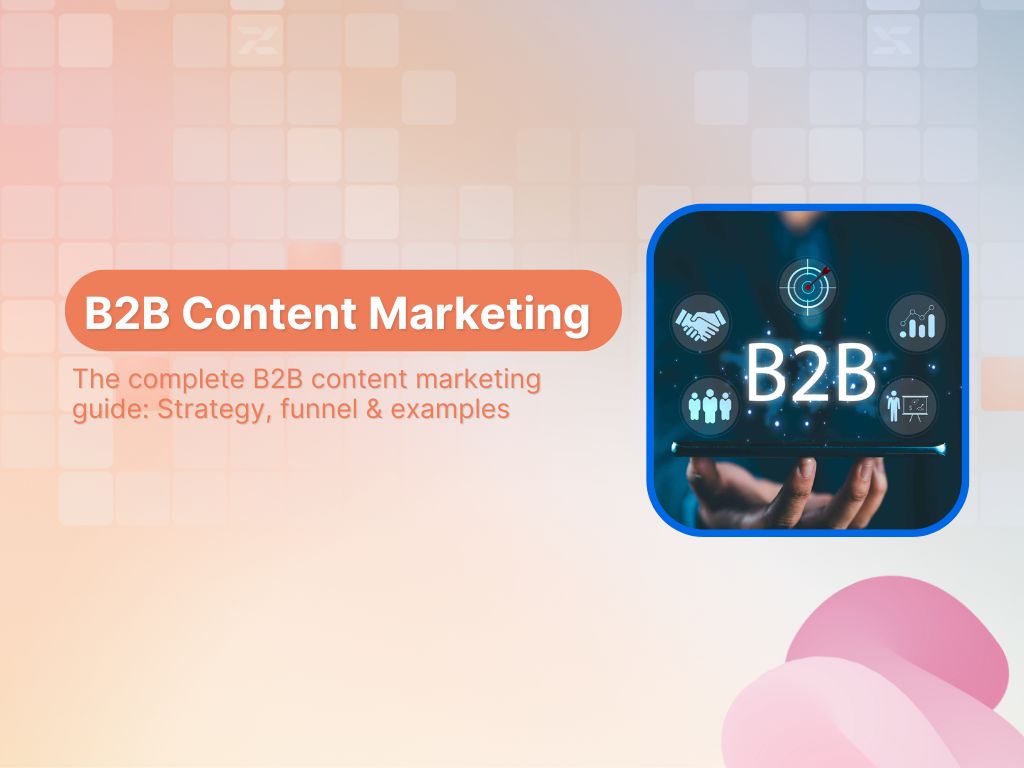How to write short blog posts that still deliver value?

The demand for a variety of content remains high, even though human attention spans are rapidly shrinking. In such a scenario, short blog posts have emerged as a powerful solution to reach busy readers who want quick, actionable insights without the commitment of going through lengthy articles.
Whether you’re an experienced content creator or just starting your blogging journey, you should master the art of optimizing content marketing strategies to boost your search rankings.
Why short blog posts are more relevant than ever?
Innovations like social media and AI have fundamentally changed how people consume content. Modern readers are bombarded with information from every direction, including social media feeds, news alerts, emails, and countless blog posts competing for their attention.
Short blog posts offer a refreshing alternative that respects your audience’s time while delivering genuine value.
Statistics show that an average person spends only 37 to 60 seconds reading a blog post. This reality doesn’t mean your content needs to be superficial; instead, it challenges you to be more strategic and intentional with every word you write.
Why short doesn’t mean less impactful
The misconception that longer automatically means better has been thoroughly debunked in the content marketing world. Short blog posts can be incredibly powerful when executed correctly. They force you to distill complex ideas into their most essential components, often resulting in clearer, more actionable content than their lengthy counterparts.
Consider some of the most viral content on social media, including tweets that spark conversations, Instagram captions that drive engagement, or LinkedIn posts that generate thousands of shares.
These examples prove that impact isn’t measured in word count but in clarity, relevance, and value delivery.
Benefits of brevity for modern readers
Today’s readers appreciate content that gets straight to the point. Short blog posts offer several advantages that make them particularly appealing:
- Faster consumption: Readers can digest the entire piece in one sitting without feeling overwhelmed
- Higher completion rates: People are more likely to read a short post from start to finish
- Better mobile experience: Shorter content is easier to read on smartphones and tablets
- Increased sharing potential: Concise, valuable content is more likely to be shared across social platforms
- Reduced bounce rates: Readers who can quickly find what they’re looking for are less likely to leave your site immediately
The key is understanding that brevity doesn’t mean sacrificing depth. It means being selective about what depth to include. When you focus on delivering one key insight exceptionally well, you often create more value than attempting to cover everything superficially.
How concise posts can still perform well in search
Search engines have evolved beyond simply rewarding long-form content. Google’s algorithm now prioritizes content that best satisfies search intent, regardless of length. Short blog posts can rank extremely well when they:
- Answer specific questions directly and comprehensively
- Target long-tail keywords with clear search intent
- Provide exactly what searchers are looking for without unnecessary filler
- Load quickly and offer an excellent user experience
- Generate high engagement metrics like low bounce rates and social shares
Does Google penalize AI content is a common concern, but the reality is that search engines care more about quality and relevance than word count. A well-optimized 500-word post that perfectly answers a searcher’s question will often outperform a 2,000-word post that meanders without focus.
1. Plan before you write for maximum clarity
The foundation of any successful short blog post lies in meticulous planning. When you have limited space to work with, every element must serve a purpose. This constraint actually becomes an advantage, forcing you to think critically about what your readers truly need to know.
Effective planning for short content requires a different mindset than planning for long-form articles. Instead of trying to cover a topic comprehensively, you need to identify the single most valuable angle and pursue it relentlessly. This approach often results in more focused, actionable content that readers can immediately implement.
Here’s how you can plan your blog posts more strategically:
Define the single goal of your post
Before writing a single word, you must crystallize exactly what you want your short blog post to achieve. This goal should be specific, measurable, and directly tied to your reader’s needs. Ask yourself:
- What specific problem am I solving for my reader?
- What action do I want them to take after reading?
- What one insight or skill should they walk away with?
For example, instead of writing about “social media marketing” (too broad), focus on “how to write Instagram captions that drive engagement” (specific and actionable). This focused approach ensures every paragraph, sentence, and word contributes to your singular objective.
Your goal should be narrow enough to cover thoroughly in your chosen word count, yet valuable enough to justify your reader’s time investment. This balance is what separates effective short content from superficial listicles that provide little real value.
Choose a focused topic that fits the short format
Not every topic is suitable for short blog posts. The most successful concise content typically falls into these categories:
- How-to guides for specific, achievable tasks
- Quick tips that readers can implement immediately
- Tool reviews focusing on key features and benefits
- Problem-solution posts addressing common pain points
- Industry updates with clear implications and takeaways
Topics that require extensive background explanation, complex multi-step processes, or comprehensive analysis are better suited for longer formats. The key is recognizing when a topic can be covered effectively within your constraints and when it needs more space to breathe.
When selecting topics, consider your audience’s context and needs. Use AI to overcome writer’s block by brainstorming multiple angles for your chosen subject, then selecting the one that offers the most immediate value in the shortest space.
Use Contentpen to create an outline instantly
Creating an effective outline is crucial for short blog posts, and Contentpen’s AI-powered research feature can dramatically streamline this process. The platform’s specialized agents analyze your topic, competitors, and target audience to suggest optimized structures that maximize impact within your word limit.
When using Contentpen for outline creation:
- Input your focused topic and primary keyword
- Review the AI-generated structure for logical flow and completeness
- Customize sections to match your specific angle and goals
- Verify each heading serves your single post objective
- Eliminate any sections that don’t directly support your main message

The platform’s ability to analyze top-ranking content for your keywords helps ensure your outline covers the essential points readers expect while maintaining the focus necessary for short-form success.
This research-backed approach gives you confidence that your structure will both satisfy search intent and deliver genuine value.
Here’s how you can create an article using Contentpen:
2. Structure your short post for readability
The structure of your short blog post can make or break its effectiveness. With limited space, every element must work harder to engage readers and guide them smoothly through your content. The best short posts feel effortless to read, creating a smooth experience that keeps readers engaged from the first sentence to your final call-to-action.
The effective structure for short content differs significantly from long-form articles. You can’t rely on multiple sections to build momentum or gradually introduce concepts. Instead, you need to capture attention immediately and maintain it throughout with clear organization and strategic formatting choices.
Start with a hook and get to the main point fast
Your opening paragraph is critical real estate in any short blog post. Unlike longer articles, where you might spend several paragraphs setting context, short posts demand immediate value delivery. Your hook should simultaneously grab attention and signal what readers will gain by continuing.
Effective opening strategies for short posts include:
- Start with a surprising statistic that highlights the problem you’re solving
- Pose a question that your readers are actively asking themselves
- Make a bold statement that challenges conventional thinking
- Share a brief anecdote that illustrates your main point
After your hook, immediately transition to your main point. Avoid lengthy introductions or excessive background information. Your readers came for specific information, and they want it quickly.
Related: Best AI tool for writing SEO-rich blog content
Use bullet points and numbered lists for clarity
Visual formatting becomes even more important in short blog posts because it helps readers process information quickly and efficiently. Strategic use of lists, bullet points, and other formatting elements can make your content feel more digestible and actionable.
Numbered lists work best when presenting:
- Step-by-step processes or procedures
- Ranked items or prioritized recommendations
- Sequential actions readers should take
- Timeline-based information
Bullet points excel for:
- Features, benefits, or characteristics
- Non-sequential tips or strategies
- Examples or case studies
- Key takeaways or summary points
Remember that formatting choices should enhance comprehension, not just break up text. Each list should serve a specific purpose in helping readers understand and apply your content. The goal is to make complex information feel simple and approachable.
Keep paragraphs and sentences short
In short blog posts, paragraph and sentence length directly impact readability and engagement. Long paragraphs can feel overwhelming on mobile devices, while complex sentences slow down comprehension and create friction in the reading experience.
Aim for paragraphs of 2-4 sentences maximum, with each sentence focusing on a single idea. This approach creates natural breathing room and makes your content feel more conversational and accessible. Short sentences also tend to be more powerful and memorable, helping key points stick with readers long after they finish reading.
Consider the visual impact of your text formatting. Large blocks of text can intimidate readers before they even start reading, while well-spaced, shorter paragraphs invite engagement and feel more manageable to consume.
3. Write fast without losing quality
Speed and quality might seem mutually exclusive, but when writing short blog posts, focused writing sessions often produce better results than lengthy, drawn-out processes. The key is developing systems and techniques that help you write efficiently while maintaining the high standards your audience expects.
Fast writing for short content requires a different approach than traditional blog writing. You need to embrace constraints as creative catalysts, using your limited word count to force clarity and precision in your messaging. This approach often results in stronger, more impactful content than you might achieve with unlimited space.
Work in short, timed writing sessions
Time constraints can be incredibly powerful for creating short blog posts. When you know you have limited time, you naturally focus on essential information and eliminate unnecessary tangents. This approach mirrors the reading experience you want to create for your audience – focused, efficient, and valuable.
Try these time-based writing techniques:
- 25-minute focused sprints using the pomodoro technique.
- 15-minute outline sessions to plan structure and key points.
- 10-minute writing bursts for individual sections.
- 5-minute editing passes to tighten language and improve flow.
During these sessions, resist the urge to edit as you write. Let your ideas flow freely, knowing you’ll refine them in dedicated editing time. This separation of creation and refinement often leads to more natural, engaging content that connects better with readers.
Also read: How to create a blog in less than 10 minutes using content presets
Stick to the essentials without over-explaining
One of the biggest challenges in writing short blog posts is determining what to include and what to cut. The temptation to over-explain concepts can quickly inflate your word count without adding proportional value. Instead, trust your readers’ intelligence and focus on providing the most crucial information clearly and concisely.
Before including any explanation or example, ask yourself:
- Does this directly support my main goal?
- Will removing this confuse my target reader?
- Can I convey this information more efficiently?
- Is this essential for taking action on my advice?
Remember that you can always link to more comprehensive resources for readers who want deeper information.
Use Contentpen to draft ideas quickly
Contentpen’s AI-powered writing features can dramatically accelerate your drafting process for short blog posts. The platform’s multiple AI agents work together to research, structure, and draft content that aligns with your brand voice while incorporating proven SEO strategies.
Using Contentpen for rapid drafting:
- Generate multiple angle ideas for your chosen topic
- Create research-backed outlines in minutes rather than hours
- Draft individual sections with AI assistance while maintaining your voice
- Optimize content structure based on competitor analysis
- Ensure keyword integration happens naturally throughout your writing

The key is using AI as a collaborative partner rather than a replacement for your expertise. Let Contentpen handle the heavy lifting of research and initial drafting, then apply your unique insights and brand perspective to create truly valuable content.
4. Edit and optimize efficiently
Editing short blog posts requires surgical precision. Every word must earn its place, and every sentence should move your reader closer to your intended goal. The editing process becomes more critical when working with constraints because you can’t afford to waste space on unclear or redundant content.
Effective editing for short content involves multiple passes, each with a specific focus. This systematic approach ensures you catch different types of issues while maintaining the overall flow and impact of your piece.
The goal is to create content that feels polished and professional while retaining the authentic voice that connects with readers.
Remove fluff and tighten language
Ruthless editing separates good short blog posts from great ones. Look for common areas where unnecessary words typically hide:
- Redundant phrases like “in order to” (use “to”) or “the fact that” (often removable)
- Weak qualifiers such as “somewhat,” “rather,” or “quite” dilute your message
- Excessive adverbs that can usually be replaced with stronger verbs
- Filler transitions that don’t add meaning or improve flow
- Repetitive information that restates previous points without adding value
Use AI to rewrite or replace weak paragraphs with stronger alternatives. Instead of “There are many benefits to using short posts,” write “Short blog posts offer multiple benefits.” This approach eliminates unnecessary words while making your writing more direct and engaging.
Check grammar, flow, and formatting
Technical accuracy becomes more noticeable in short blog posts because errors have nowhere to hide. A single grammar mistake or awkward sentence can disrupt the entire reading experience when you only have a few hundred words to work with.
Focus your proofreading efforts on:
- Sentence variety to maintain reader interest and improve flow
- Transition quality between paragraphs and sections
- Formatting consistency in headings, lists, and emphasis
- Grammar and spelling accuracy throughout
- Voice consistency that aligns with your brand
Read your post aloud or use text-to-speech software to catch awkward phrasing that might not be obvious when reading silently. This technique is particularly effective for identifying sentences that are too long or complex for your target format.
Add keywords and links without overloading
SEO optimization for short blog posts requires finesse. You have fewer opportunities to naturally incorporate keywords and internal links, making each instance more important. The goal is seamless integration that enhances rather than disrupts the reading experience.
Strategic keyword placement for short content:
- Include your primary keyword in the title, first paragraph, and at least one subheading
- Distribute secondary keywords naturally throughout the body content
- Use keyword variations to avoid repetition while maintaining relevance
- Bold key terms strategically to improve scannability and SEO signals
For internal linking, focus on resources that genuinely add value for readers wanting to explore related topics.
Also read: How to automate internal and external linking using Contentpen
Conclusion
Writing effective short blog posts is both an art and a science. Success comes from careful planning that defines clear goals, efficient writing that eliminates unnecessary elements, and strategic editing that optimizes every word for maximum impact. Remember: plan with purpose, write with focus, edit ruthlessly, and optimize thoughtfully.
The beauty of short-form content lies in its accessibility, both for writers and readers. You can create valuable content more quickly, and your audience can consume it more easily. This efficiency doesn’t compromise quality; instead, it demands higher standards for clarity and relevance.
Ready to streamline your content creation process? Start your free trial with Contentpen, and discover how AI-powered writing tools can help you create compelling short blog posts faster than ever before.
With features like automated research, brand voice integration, and SEO optimization, you’ll wonder how you ever managed content creation without it.
FAQs about short blog posts
How short should a blog post be?
Short blog posts typically range from 300 to 800 words, though the ideal length depends on your topic and audience needs. The key is including enough information to provide genuine value while respecting your readers’ time constraints. Focus on completeness rather than hitting a specific word count; some topics require 300 words, others need 600.
Can short blog posts rank on Google?
Absolutely. Short blog posts can rank exceptionally well when they target specific keywords and satisfy search intent effectively. Google’s algorithm prioritizes content that best answers users’ questions, regardless of length.
How often should I publish short content?
Short content allows for more frequent publishing because it requires less time to create. Many successful blogs publish short blog posts 2-3 times per week, using the efficiency gains to maintain consistent output.
Should I use AI tools like Contentpen for short posts?
AI tools like Contentpen excel at creating short blog posts because they can quickly research topics, generate focused outlines, and draft concise content that maintains quality and relevance. You should learn how to use AI for content creation effectively to significantly reduce the time investment while improving consistency and SEO optimization.
You might be interested in...

The complete B2B content marketing guide: Strategy, funnel & examples
B2B content marketing is something that can make or break your business. You might already be familiar with its basics, but it is important to discuss it in detail in terms of types, benefits, examples, and strategies to implement a successful B2B content marketing strategy. And if you are wondering why you need B2B content […]
Oct 29, 2025

Content marketing examples that drive results in 2025
Here’s a sobering truth: 96% of content published online gets zero traffic from Google. Zero! Yet the examples you’re about to see generated millions of views, thousands of shares, and drove real business results. What makes them different? They didn’t follow the “publish and pray” strategy! Instead, each one used a specific psychological trigger, solved […]
Sep 29, 2025

What is blogging? The ultimate guide
Should I start my own blog? Is blogging dead? Can I get paid for blogging? What does blogging even mean in this age of AI? These are some of the most common questions associated with blogging, and we’ll be answering all of them in detail to understand what blogging is. Blogging has changed a lot […]
Sep 17, 2025